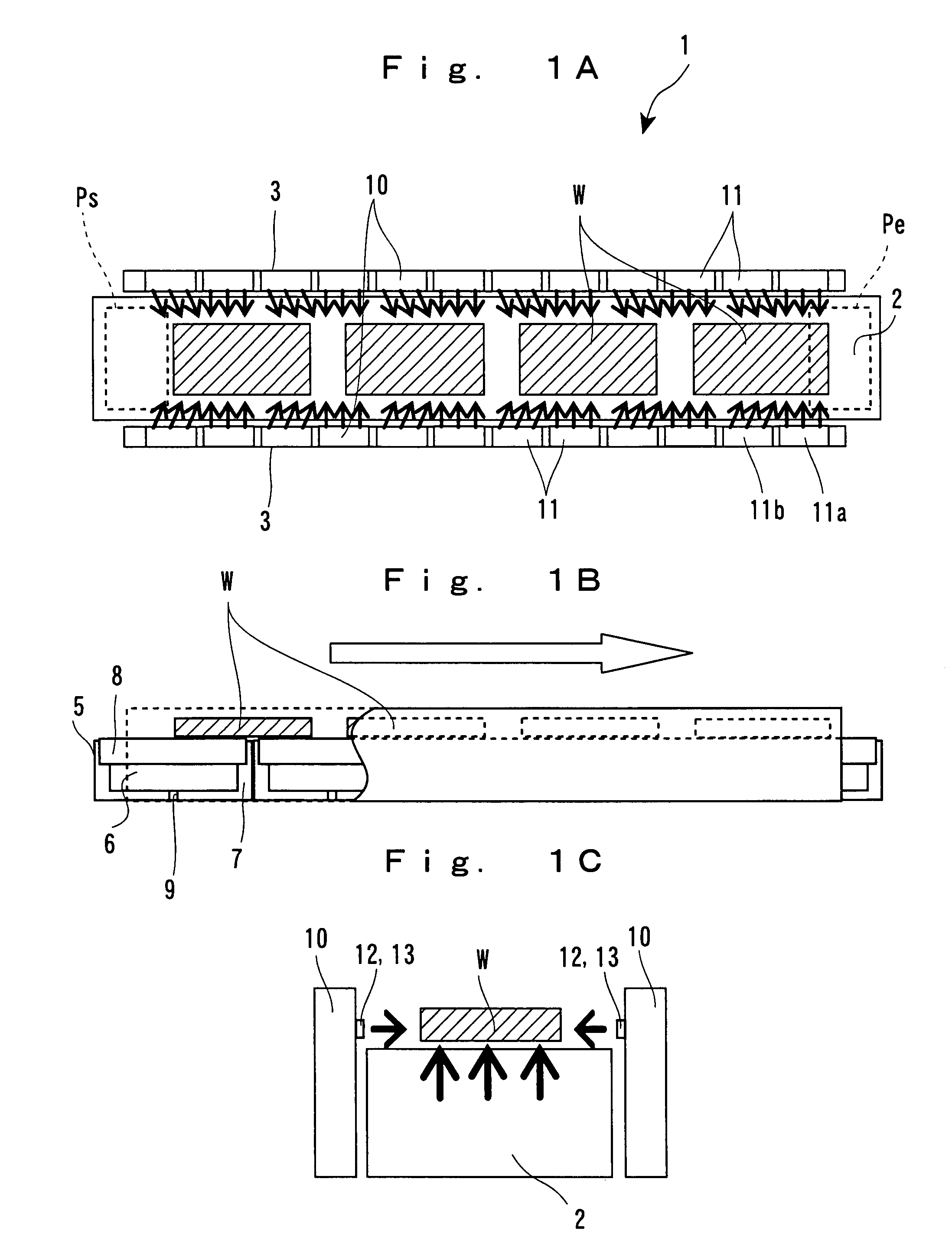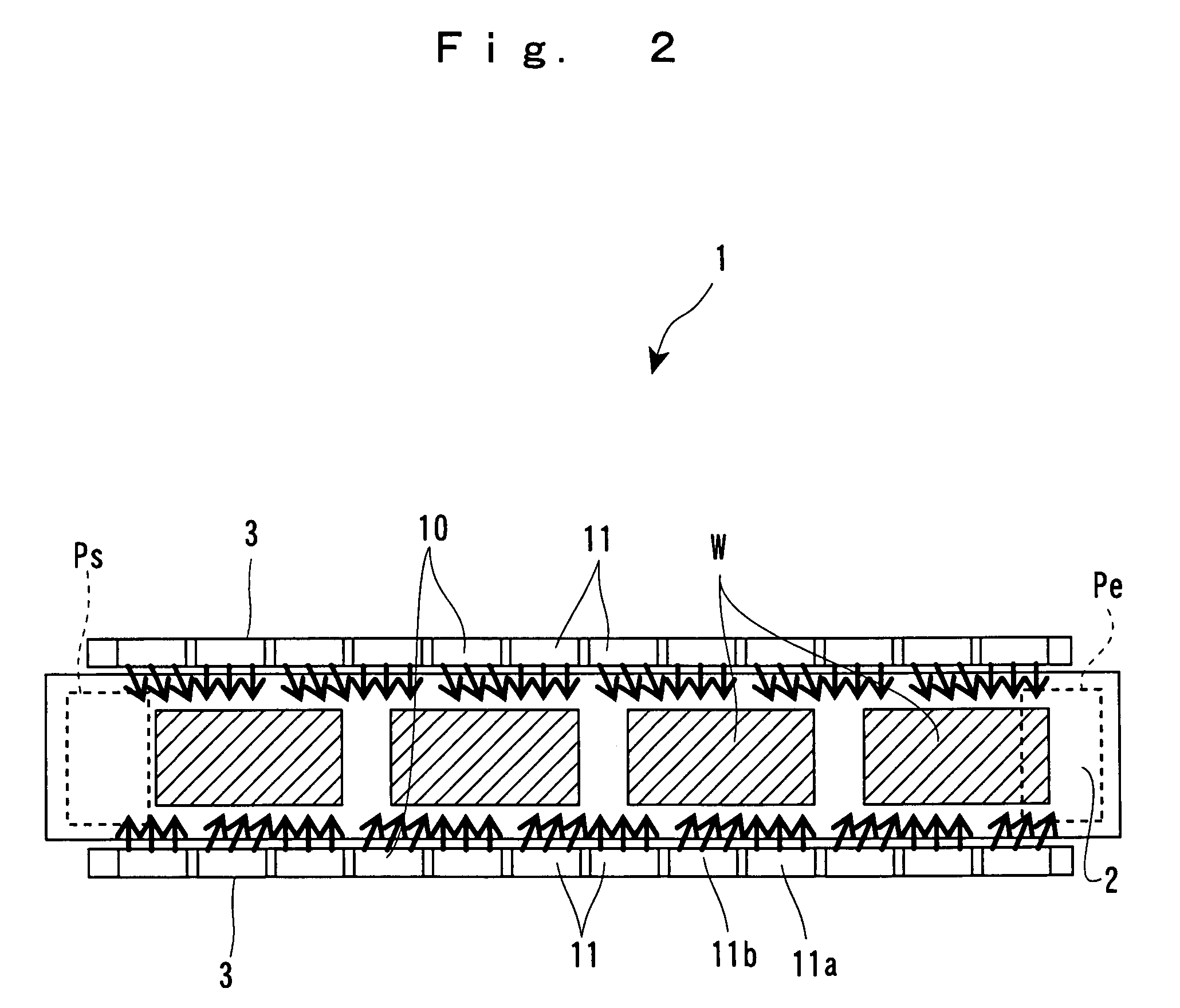Workpiece conveyor and method of conveying workpiece
a workpiece and conveyor technology, applied in the direction of basic electric elements, loading/unloading, electrical equipment, etc., can solve the problems of workpiece damage, increased air consumption, and inability to convey workpieces, etc., to achieve the effect of conveying workpieces properly and efficiently, simple configuration, and small amount of air
- Summary
- Abstract
- Description
- Claims
- Application Information
AI Technical Summary
Benefits of technology
Problems solved by technology
Method used
Image
Examples
second embodiment
[0116]Referring next to FIGS. 6A to 6C, a description will be made about the workpiece conveyor of a Note that only different parts will be described herein to avoid overlaps. The workpiece conveyor 1 includes: a workpiece conveying mechanism 4 composed of the above-described workpiece conveying path 2 serving as a conveying path for a plurality of workpieces W and composed of the above-described pair of air-blowing units 3 which are standingly provided along both sides of the workpiece conveying path 2 and give propulsion to the workpiece W; a plurality of intermediate air-dropping units 55 which are disposed above the workpiece conveying path 2 and maintain gaps between the plurality of conveyed workpieces W; a baffle plate 66 which is disposed ahead of the conveyance ending position Pe of the workpiece conveying path 2 and extends in a direction orthogonal to the conveying direction; and an end air-dropping unit 77 which blows air from above to the gap between the baffle plate 6...
third embodiment
[0123]Referring next to FIGS. 8A to 8C, a description will be made about the workpiece conveyor according to a The workpiece conveyor used herein has a workpiece such as a glass substrate used with a liquid crystal panel mounted on a belt conveyor and conveys the same. At that time, the workpiece conveyor makes it possible to perform prealignment of the workpiece. The workpiece conveyor 1 includes a belt conveyor 20 and the pair of air-blowing units 3 standingly provided along both sides of the belt conveyor 20. The pair of air-blowing units 3 extend slightly shorter in length than the belt conveyor 20 from the conveyance starting position Ps to the conveyance ending position Pe of the belt conveyor 20 and blow air to the workpiece W conveyed by the belt conveyor 20 from both sides.
[0124]The belt conveyor 20 includes: a driving pulley 50 which is rotated by a driving motor (not shown) through a reduction gear train or the like; a driven pulley 60 which is driven by the driving pull...
fourth embodiment
[0129]Referring next to FIGS. 10A to 10C, a description will be made about the workpiece conveyor according to a The workpiece conveyor 1 includes: the pair of belt conveyors 20 on which the workpiece w is straddlingly mounted and conveyed; separation distance adjusting mechanisms 90 which are provided at the front and rear parts of the pair of belt conveyors 20 in the conveying direction and adjust a separation distance between the pair of belt conveyors 20; and the pair of air-blowing units 3 provided along both sides of the pair of belt conveyors 20. The pair of air-blowing units 3 extend slightly shorter in length than the pair of belt conveyors 20 from the conveyance starting position Ps to the conveyance ending position Pe of the pair of belt conveyors 20 and blow air to the workpiece W conveyed by the pair of belt conveyors 20.
[0130]The respective belt conveyors 20 include: the driving pulley 50 which is rotated by a driving motor (not shown) through a reduction gear train o...
PUM
 Login to View More
Login to View More Abstract
Description
Claims
Application Information
 Login to View More
Login to View More - R&D
- Intellectual Property
- Life Sciences
- Materials
- Tech Scout
- Unparalleled Data Quality
- Higher Quality Content
- 60% Fewer Hallucinations
Browse by: Latest US Patents, China's latest patents, Technical Efficacy Thesaurus, Application Domain, Technology Topic, Popular Technical Reports.
© 2025 PatSnap. All rights reserved.Legal|Privacy policy|Modern Slavery Act Transparency Statement|Sitemap|About US| Contact US: help@patsnap.com



